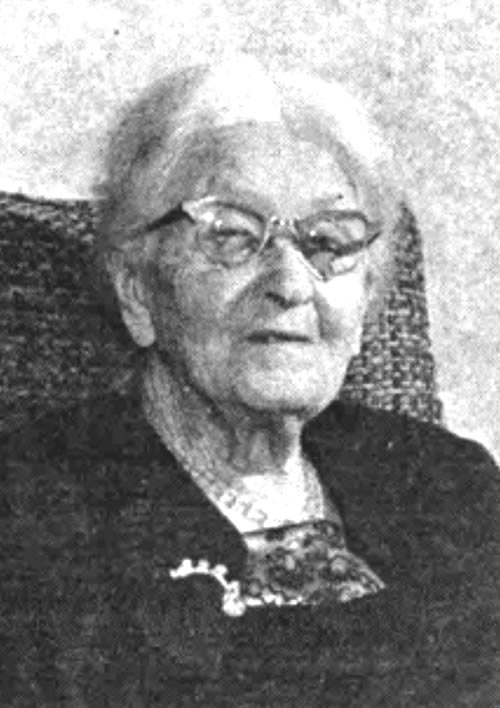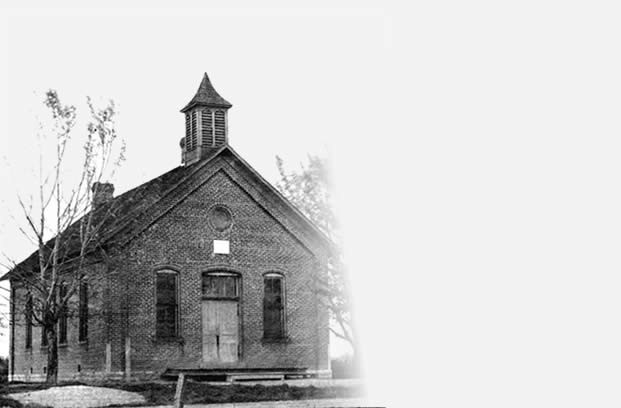
Sarah Holtkamp
The community of New Knoxville is looking forward to the observance of the one hundredth birthday of its oldest citizen, native-born Mrs. Sarah E. Holtkamp, who has lived longer than any other resident of German origin in this vicinity. Mrs. Holtkamp, widow of Ernst H. Holtkamp, will attain the age of 100 on March 11. In her home, assisted by her son and daughter, she will receive friends Monday afternoon, March 11.
All through her adult life the centenarian has been esteemed as one of the gracious ladies of the community. She has been a gifted, kindly helper of the ailing and needy, and an encouraging support to the strong. Excellent health has stood her in good stead, and she still kneads and bakes her own bread, tends flowers, of which she is fond, and performs other household chores. In her retentive memory she carries the history of the area from its very beginnings. She reads newspapers and books, has taken the changing times in stride, and is alertly interested in current affairs.
Aside from farming, the Holtkamp family tradition has been one of scholarship and music. The late Ernst Holtkamp was a school teacher and a talented organist. Son and daughter have followed in parental footsteps, both are graduates of the Conservatory of music of Oberlin College.
Children’s Careers
Daughter Esther has taught music for many years at New Knoxville. The son, Prof. Otto H. Holtkamp, for 40 years was on the music faculty of Bluffton College. After his retirement he opened a studio in Findlay, where he and his wife now live. Their son, William F. Holtkamp, is a teacher, plays in a symphony orchestra and manages a music store in Boise, Idaho. A daughter, Mrs. Wayne Golly, lives at Covina, Calif.; another daughter, Mrs. Roger Bell, at Findlay. Both have musical interests.
One of the early Ohio-born members of the Holtkamp family taught music and owned a music store before moving to Cleveland to engage in organ manufacturing. His firm has installed pipe organs in churches throughout the mid-West. The forbears of the Holtkamps were part of mass migration, beginning in the 1830s, from the poverty stricken community of Ladbergen, Westphalia, Germany. The motive for leaving was their hope for a better life on the inexpensive but fertile land near a hamlet called New Knoxville, in what is now Auglaize County.
Among those planning to leave Ladbergen in 1842 were Herr and Frau Heinrich Snethkamp with a toddling son. But when a daughter was born in February of that year the parents had misgivings about embarking on an arduous journey. The baby, however, who was to become the mother of Mrs. Sarah Holtkamp in America, was healthy, strong and nursing well at the age of two months, and apparently equal to the trip. In April, as planned, the family boarded a sailing vessel at the busy seaport of Bremen with all their earthly belongings. After a rough voyage of months, cooped in the gloomy and stagnant steerage, they landed at Philadelphia. Their journey inland was by wagon to Wheeling, by steamer to Cincinnati, then on the new Miami and Erie Canal until the boat came to a dead halt at Piqua. Navigation was interrupted here because the canal builders had encountered the formidable obstacle of a glacial moraine of huge rocks and hard clay. It took three years by pick and shovel, to cut a channel half a mile long and in places 50 feet deep near present-day Spencerville. The cut, since known as the Deep Cut, has been designated as a national historic landmark by the U. S. Park Service to be improved and beautiful this year.
At Piqua the already weary immigrants had to resort to oxen and wagon over narrow, rutted roads to their destination, where they arrived in cold mid-December, eight months after they had left their native heath. Traveling the entire trip with the Snethkamps was another Ladbergen family, Herr and Frau Adolf Meckstroth and a small son. The two families were to occupy the same log cabin which earlier settlers, friends of theirs had erected at New Knoxville for the expected newcomers.
Tragedy Strikes
The immediate, vital concern was the clearing of a patch of forest near the cabin for spring planting of Indian corn and a few other edibles. This work of wielding axes from dawn to dusk, chopping and burning the timber, had progressed less than two months when the brothers-in-law, Heinrich and Adolf, were killed by a giant tree they were felling. The bereaved, widowed mothers suddenly found themselves without mates. They were in need of new breadwinners. And, among their neighbors, were willing and able single men with whom they had been acquainted in Germany. Widow Snethkamp married Herman W. Meckstroth, Adolf’s younger brother. Her sister, Adolf’s widow, was wedded to the pioneer schoolmaster, F. W. H. Kuckherman, who soon became the first pastor of the newly organized local church. The little Snethkamp girl, who had lost her father in a tree fall, was reared to young womanhood in the home of stepfather Meckstroth.
Sarah is Born
By this time there were native-born as well as immigrant young men to seek her hand. She chose Ohio-born Henry W. Lutterbeck, who was to achieve local fame as a most prosperous farmer. To this union was born the now 100-year-old Sarah Lutterbeck Holtkamp. When Mrs. Holtkamp first saw the light of day, just after the Civil War, most of the timber in the area was still standing. She witnessed the appearance of thriving pioneer enterprises, such as sawmills, furniture and cabinet factories, brick and drainage tile kilns, blacksmith and saddlery shops, and others.
In due course these one-time vital businesses were to disappear with one notable exception, the Hoge Lumber Company, whose repeated modernizations and expansions have made the New Knoxville community a widely known center of lumber production and wood processing for markets from coast to coast and in Europe.
Mrs. Holtkamp is by far the oldest confirmand of New Knoxville’s First United Church of Christ, formerly the German Reformed Church. Its attractive brick edifice and towering steeple, striking clock, resounding bell and chimes are visible and audible for miles around. More than 50 young men in this essentially rural church have been ordained for the ministry. The Christian Century, magazine of national circulation, after a survey, in 1950, ventured the opinion that no other congregation in the nation has produced so many clergymen, an appraisal which has not been challenged.
In her lifetime of a century Mrs. Holtkamp has been an integral part of, and has contributed much to, the building of a virile community consisting of an industrial village of 800 inhabitants and a rich encircling farming area of several thousand kindred people of German origin.
NOTE: Mrs. Holtkamp resided at 201 S. Main Street, and she died March 4, 1973, just a week before her 105th birthday.
NOTE: ABOUT THE AUTHOR: Jake Meckstroth was a native of New Knoxville and an accomplished journalist.
From the UPI Archives, Feb. 10, 1985:
COLUMBUS, Ohio -- Jacob A. 'Jake' Meckstroth, who wrote campaign speeches for U.S. Senate candidate Warren G. Harding and trained many prominent editors, will be buried Tuesday in his native New Knoxville, Ohio. He died Saturday at age 97.
Meckstroth was a member of the first journalism graduating class at Ohio State University in 1912. His long career in journalism, political and public service ended in 1959 when he retired as editor of the Ohio State Journal when it merged with the Columbus Citizen. He began his newspaper career in 1912 as a reporter for the Dayton Journal, then worked for the Dayton Herald and Canton Repository before joining the Ohio State Journal in 1913.
Meckstroth wrote speeches for Harding when the future president ran for the Senate. But Meckstroth served as publicity man for James Cox, who opposed Harding for the Democratic nomination for president in 1920. Meckstroth served as secretary to Ohio Gov. Vic Donahey from 1923 to 1929.
In 1920, he returned to the Journal as a political writer and became editor the following year, a position he held for 38 years. During his tenure, The Wall Street Journal and five other newspapers had editors who had begun their careers under him at the Ohio State Journal.


